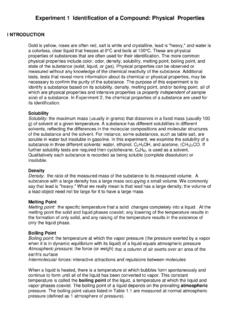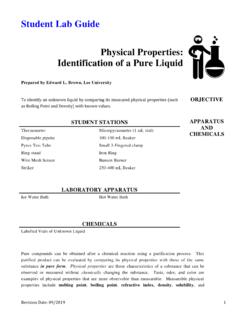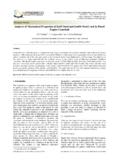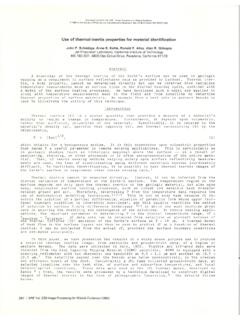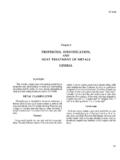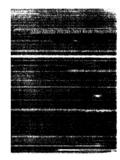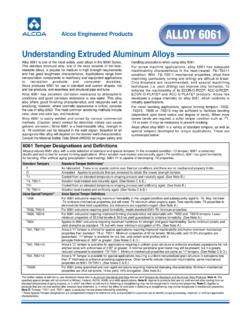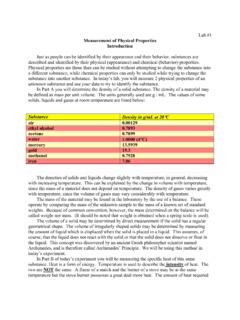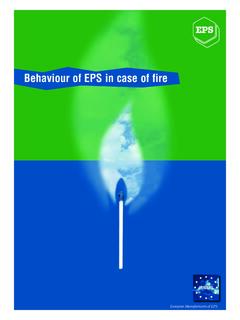Transcription of Experiment3 Identification of a Compound: Chemical
1 Experiment 2 Identification of a compound : Chemical properties Introduction Chemists and scientists in general, develop and design experiments in an attempt to understand, explain, and predict various Chemical phenomena. Carefully controlled (laboratory) conditions are needed to minimize the many parameters that affect the observations. Chemists organize and categorize their data, and then systematically analyze the data to reach some conclusion: often, the conclusion may be to carefully plan more experiments! It is presumptuous to believe that a chemist must know the result of an experiment before it is ever attempted; most often an experiment is designed to determine the presence or absence of a substance or to determine or measure a parameter. A goal of the environmental or synthesis research chemist is, for example, to separate the substances of a reaction mixture together one generated in the laboratory or one found in nature) and then identify each substance through a systematic, or sometimes even a trial-and- error, study of their Chemical and physical properties .
2 As you will experience later, Qualitative Analysis Experiments are designed to identify a specific ion (by taking advantage of its unique Chemical properties ) in a mixture of long through a systematic sequence of analyses. On occasion an experiment reveals an observation and data that are uncharacteristic of any other set of properties for a known substance, in which case either a new compound has been synthesized/discovered or experimental errors and/or interpretations have infiltrated the study. In this experiment, you will observe Chemical reactions that are characteristic of various compounds under controlled conditions. After collecting and organizing your data, you will be given an unknown compound , a compound that you have previously investigated its Chemical properties . The interpretations of the collected data will assist you in identifying your compound .
3 What observations will you be looking for? Chemical changes are generally ac- companied by one or more of the following: A gas is evolved. This evolution may be quite rapid or it may be a "fizzing" sound A precipitate appears (or disappears). The nature of the precipitate is important; it may be crystalline, it may have color, it may merely cloud the solution. heat may be evolved or absorbed. The reaction vessel becomes warm if the re- action is exothermic or cools if the reaction is endothermic. A color change occurs. A substance added to the system may cause a color change. The Chemical properties of the following compounds, dissolved in water, are investigated in Part A of this experiment: Sodium chloride NaCl(aq) Sodium carbonate Na2CO3(aq) Magnesium sulfate MgSO4(aq) Ammonium chloride NH4Cl(aq) Water H2O(l) The following test reagents are used to identify and characterize these compounds: Silver nitrate AgNO3(aq) Sodium hydroxide NaOH(aq) Hydrochloric acid HCl(aq) In Part B of this experiment the Chemical properties of five compounds in aqueous solutions, labeled 1 through 5, are investigated with three reagents, labeled A, B, and C.
4 All possible Chemical tests will be performed with these eight solutions. An unknown will then be issued and matched with one of the solutions, labeled 1 through 5. EXPERIMENTAL PROCEDURE Procedure Overview: You will conduct a test on each known compound in the five aqueous solutions and the unknown compound with a single test reagent. It is therefore extremely important that you are organized and that you describe your observations as completely and clearly as possible. The Report Sheet provides a "reaction matrix" for you to describe your observations; because the space is limited, you may want to devise a code, for example: p--precipitate c---cloudy nr--no reaction g-gas, no odor go--gas, odor A. Chemical properties of Known Compounds Observations with Silver Nitrate Test Reagent. Use a permanent marker to label five small, clean test tubes or set up a clean 24-well plate.
5 Place 5-10 drops of each of the five "known" solutions into the labeled test tubes (or wells A1-A5). Use a dropper pipet (or a dropper bottle) for the delivery of the silver nitrate solution. (Caution: AgNO3 forms black stains on the skin. The stain, caused by silver metal, causes no harm.) If after adding several drops you observe a chemicalchange, add 5-10 drops to see if there are additional changes. Record your observations in the reaction matrix on the Report Sheet. Save your test solutions. 2. Observations with Sodium Hydroxide Test Reagent. Use a permanent marker to label five additional small, clean test tubes. Place 5-10 drops of each of the five "known" solutions into this second set of labeled test tubes (or wells B1-B5). To each of these solutions slowly add 5-10 drops of the sodium hydroxide solution; make observations as you add the solution.
6 What observations are made? Check to see if a gas evolves in any of the tests. Check for odor. What is the nature of any precipitates that form? Observe closely. Save your test solutions for reference in Part 3. Observations with Hydrochloric Acid Test Reagent, Use a permanent marker to label five additional small, clean test tubes . Place 5-10 drops of each of the five "known" solutions into this third set of labeled test tubes (or wells C1-C5); add the hydrochloric test reagent to the solutions and record your observations. Check to see if any gas is evolved. Check for odor. Observe closely. Save your test solutions for reference in Part A. 4. Identification of Unknown. Obtain an unknown for Part A from your laboratory instructor. Repeat the three tests with the reagents in Parts , 2, and 3 on your unknown. On the basis of the data from the "known" solutions (collected and summarized in the reaction matrix) and that of your unknown solution, identify the compound in your unknown solution.
7 CLEANUP: Rinse the test tubes or well plate twice with tap water and twice with deionized water. B. Chemical properties of Unknown Compounds The design of the experiment in Part B is similar to that of Part A. Therefore, an equal number of test tubes or a 24-well plate is necessary. 1. Preparation of Solutions. On the reagent shelf are five solutions, labeled 1 through 5, each containing a different compound . Use small clean test tubes or the well plate as your testing laboratory. About 1 mL of each test solution is necessary for analysis. 2. Preparation of Reagents. Also on the reagent shelf are three reagents labeled A, B, and C. Use a dropper pipet (or dropper bottle) or a Beral pipet to deliver Reagents A through C to the solutions. If, after adding several drops, you observe a Chemical change, add 5-10 drops more to see if there are additional changes.
8 3. Testing the Solutions. Test each of the five solutions with drops (and then excess drops) of Reagent A. Observe closely and describe any evidence of Chemical change; record your observations. With a fresh set of solutions 1-5 in clean test tubes (or wells), test each with Reagent B. Repeat with Reagent C. 4. Identification of Unknown. An unknown solution will be issued that is one of the five solutions from Part On the basis of the data in your reaction matrix and the data you have collected, identify which of the five solutions is your un- known. CLEANUP: Rinse the test tubes or well plate twice with tap water and twice with deionized water. Name _____ Experiment 3 Prelaboratory Assignment Identification of a compound : Chemical properties 1. What is the purpose of this lab? 2. As a result of the mixing of the test solutions with the reagent solutions in Part A of the experiment, the following salts are formed.
9 Refer to Appendix G to determine which of the salts are considered insoluble. a. AgCl b. AgCO3 c. Ag2SO4 d. Mg(NO3)2 e. NH4NO3 f. Mg(OH)2 3. Three test tubes, with no labels, are in a test tube rack on the laboratory bench. Lying beside the test tubes are three labels: potassium iodide, Kl, silver nitrate, AgNO3, and sodium sulfide, Na2S. You are to place the labels on the test tubes using only the three solutions present, Here are your tests: A portion of Test Tube 1 added to a portion of Test Tube 3 produces a yellow, silver iodide precipitate. A portion of Test Tube 2 added to a portion of Test Tube 3 produces a black, silver sulfide precipitate. Your conclusions are: Name _____ Experiment 2 Identification of a compound : Chemical properties Data Table: A. Chemical properties of Known Compounds NaCl(aq) Na2CO3(aq) MgSO4(aq) NH4CI(aq) H2O(l) AgNO3(aq) NaOH(aq) HCl(aq) B.
10 Chemical properties of Unknown Compounds 1 2 3 4 5 A B C Conclusion Questions 1. Identify Solutions 1-5 and Test Reagents A-C. 2. Three test tubes, with no labels, are in a test tube rack on the laboratory bench. Lying beside the test tubes are three labels: silver nitrate, AgNO3, hydrochloric acid, HCl, and sodium carbonate, NaCO3. You are to place the labels on the test tubes using only the three solutions present. Here is your analysis procedure: A portion of Test Tube 1 added to a portion of Test Tube 2 produces carbon dioxide gas, CO2. A portion of Test Tube 1 added to a portion of Test Tube 3 produces a white, silver carbonate precipitate. a. On the basis of your observations how would you label the three test tubes? b. What would you expect to happen if a portion of Test Tube 2 is added to a portion of Test Tube 3?
